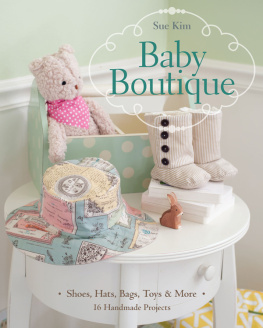Contents
Guide
KNICKERS!
Six styles of smalls to make,
from sweet cami to saucy Brazilian

DELIA ADEY & ERIKA PETO


www.stitchcraftcreate.co.uk
Contents
Introduction
Knickers, pants, panties, bloomers, briefs, shorties, drawers, pantaloons, tangas, thongs theyve had different names and shapes throughout history, changing with the shape and style of the fashion worn and the fabrics available. Our little book picks out our favourite shapes and fun styles that can be made at home with little expense.
Lingerie making has always had a little mystery about it but the truth is theyre just smalls and they make lovely little sewing projects. We hope to demystify this and make sewing your smalls fun.
If youre reading this in America (or anywhere else where pants mean trousers and knickers could mean anything at all), you might need to know that knickers is a classic British term for ladies underwear and carries with it the concept of frills, frivolity and fun. Its also something the Brits have been known to utter as an exclamation when things havent gone quite as planned!
We hope you enjoy making these knickers, and then wearing your end products even more!


BEFORE YOU Begin
Materials
YOU HAVE A CHOICE TO MAKE BEFORE YOU SET OUT ON YOUR UNDERWEAR ODYSSEY:
WHAT FABRIC ARE YOU GOING TO MAKE YOUR KNICKERS FROM?
The knickers in this book use different fabrics and the pattern you are following will guide you. We have also given alternatives that can be used. So that you can make an informed decision, here is our overview of suitable materials and the qualities that each one has.
Woven cotton
Cotton is a natural woven fabric, which means that its fibres form a warp and a weft. The warp is the vertical fibre and the weft runs horizontally from one side to the other. The edge where the weft fibre curves round creates the selvedge, the non-fraying edge of the fabric. Cotton does not stretch when pulled horizontally or vertically. It does give a little when pulled diagonally. This is called the bias.
Cotton lawn
Cotton lawn is a plain weave textile, designed using high count yarns, which result in a silky smooth feel. It is beautiful and light and perfect for making underwear, and gives a silk-like feel while at the same time being easier to manage than silk when sewing.
Silk
Silk is the name of the fibre spun from insect larvae. The best known silk is from the larvae of the Mulberry silk worm, Bombyx Mori, which is reared in captivity for industry. They are larvae moths. Silk originates from Asia where it is still made today. It has always been associated with luxury products and favoured throughout history by royalty and the rich. Its a beautiful textile to wear, breathable, light and soft against the skin.
To sew with it is a bit tricky as it tends to slip and move when cutting. As you get more confident with sewing it is worth persevering with silk because of the lovely results that you can achieve.
Stretch cotton jersey
Jersey is a knit fabric originally made from wool but now made from a combination of wool, cotton and synthetic fibres. It was first made in Jersey (Channel Islands) in medieval times. As the fibres are knitted together instead of woven, a stretchy fabric is created. It is often used to make t-shirts and has become a staple of modern wardrobes.
By adding Lycra the jersey fabric has become even stretchier. Knickers are best made with a four-way stretch, a jersey with added Lycra. You can tell this by pulling it with your hands and feeling the amount of ping it has when it returns to the pre-pulled shape. The more stretch in the fabric the more hold your underwear will have to stay up! It makes very comfortable underwear and is a modern favourite.
Stretch it and see!
A LITTLE lYCRA GOES A LONG WAY. tO FIND OUT IF A FABRIC MIGHT CONTAIN SOME, TRY THE FOLLOWING STRETCH TESTS.
ONE WAY STRETCH
Stretch on the cross grain and no recovery (no Lycra)
TWO WAY STRETCH
Stretch and recovery on the cross grain (contains Lycra)
FOUR WAY STRETCH
Stretch and recovery on the cross grain and the lengthwise grains (contains Lycra)
Lycra is a synthetic fibre which can be mixed with many other fabrics natural and synthetic; wool, cotton, nylon, polyester. It revolutionized clothing and underwear especially sports clothing. It is ideal for tight fitting garments and perfect for comfortable knickers.
Trims and Elastics
All knickers need some sort of trim or elastic to hold them up and to keep the garment in the required place against the body.
Knickers made from non stretch (woven) fabrics like cotton need to have elastic in the waistband and with most knickers, except for camisole knickers, around the legs. For the cotton original, and ribbon-tie knickers in this book we have used a knicker elastic approximately 1cm (12in) wide. Half of the elastic is made up of a frill or a loop, which sits over the edge of the knickers, to serve as a decorative edge. Weve used the same size elastic on the waistband and the legs, but for different looks and designs vary the size of the two elastics.
When making knickers from stretch fabrics knicker elastic can be used but you could choose stretch lace which adds a more decorative finish. Stretch lace doesnt have the same elasticity as elastic but because the fabric is clinging to the body shape already the trim doesnt have to work as hard as the elastic on the cotton knickers. The result is a more comfortable feeling when worn. Stretch lace comes in various sizes from 1cm (12in) width up to 20cm (8in) wide. We use a 4cm (112in) width for our knickers. Again, it overlaps the edge of the material and becomes a decorative feature to the garment. Stretch lace can also come with a variety of shaped edges, some are curved or scalloped which adds further to the design.
Finding the right trims can be fun and sometimes a seemingly never-ending mission! We always have our eyes peeled for new and old lace trims, and we stock a good selection at the Flo-Jo shop. Were forever on the look out for unusual and old pieces at antique fairs and markets. Unlike lace, elastic does have a shelf life and unfortunately does perish with age so be careful and test the stretch of your elastic if you are buying genuine vintage trims in this way.
Tools
KNICKER-MAKING TOOLS ARE NOT RARE OR UNUSUAL, IN FACT IF YOU DO A BIT OF SEWING ALREADY YOU WILL PROBABLY HAVE EVERYTHING YOU NEED.
The six projects in this book do all require a sewing machine, but you dont have to have an expensive or specialized one. The only requirement apart from a straight stitch is that it has a zig-zag stitch, which is a key part of applying elastic and so a key part in keeping your knickers up! Most modern machines, post 1950, have a zig-zag stitch, hand-powered machines tend not to.
















